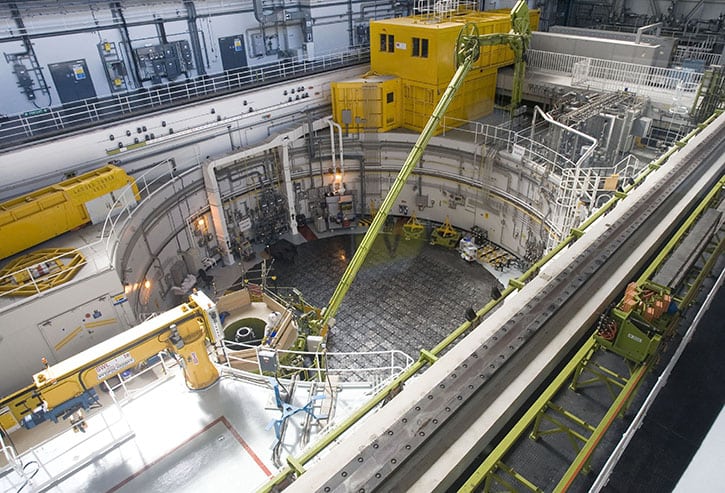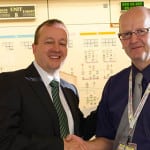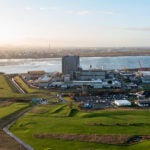EDF Energy announced on February 16 that it is extending the closure dates for four of its nuclear plants in the UK.
Heysham 1 and Hartlepool will be extended by five years to 2024, while Heysham 2 and Torness will be extended seven years to 2030. The decision follows extensive technical and safety reviews, according to the company.
“It’s a great achievement by thousands of EDF Energy staff and partners in the supply chain who have worked so hard to show that we can deliver on performance, reliability and safety,” said Vincent de Rivaz, CEO of EDF Energy.
Heysham is located on the northwest coast of England near Lancaster. The site is divided into two separate stations; the 1,155-MW Heysham 1 began operation in 1983, while the 1,230-MW Heysham 2 opened in 1988. Hartlepool, meanwhile, is located on the northeast coast of England, and Torness is on the east coast of Scotland, about 30 miles east of Edinburgh. Those plants began operation in 1983 and 1988, respectively.
Advanced Gas-Cooled Reactors Offer UK Options
The four stations are of the advanced gas-cooled reactor (AGR) type. They each have two reactors contained in a single building. The design is the second generation of British gas-cooled reactors (Figure 1) that use CO2 as a coolant and graphite as the neutron moderator. The AGR was developed from the Magnox reactor, the last of which—Wylfa Nuclear Power Station—was retired at the end of last year. Today’s announcement follows life extensions at EDF Energy’s other AGR power stations.
 |
| 1. This image shows the radiological controlled area at the Torness station. Courtesy: EDF Energy |
The UK government expects that the margin between supply and demand will be affected in the coming years as old power stations close, owing to plants reaching the end of their lifespans. A 2015 report published by the House of Lords suggests that around a fifth of the generation capacity available in 2011 will close by 2020. The government estimates that £110 billion ($157.34 billion) of investment in new power stations and grid infrastructure is needed to replace this lost capacity.
Two government policies were instrumental in EDF Energy’s decision to move the scheduled closure dates. The company said the UK’s “Carbon Price Floor” encourages generation from low-carbon sources like nuclear, while its “Capacity Market” ensures the UK has the power it needs.
“In today’s extremely challenging market conditions, our belief that Government policy will be maintained and strengthened gives us the confidence to invest in our nuclear stations,” de Rivaz said.
Local Economies Benefit
The news was welcome to at least some residents of the local communities.
“I think hearing the news today that Torness is going to be extended a further seven years beyond its current lifespan is fantastic news,” said Philip Mellor, owner of the Dunmuir Hotel in Dunbar. “I think for the town, the extension is another piece of really good news. It continues to keep the town vibrant. It keeps people here. It keeps jobs in the local economy very strong.”
David Morris, the member of British Parliament who represents the Heysham area, was also pleased. “Today’s announcement is fantastic news for the whole economy in Morecambe and Lunesdale. This joint life extension of our Powerstations is something I have been campaigning for,” Morris said.
“Our power stations in Heysham are brilliantly maintained by the staff,” he added.
EDF Energy Nuclear Plants Operating Well
Statistics seem to support the notion that the plants are operating well. In 2015, EDF Energy’s output from its eight nuclear plants was 60.6 TWh, the highest level in 10 years and 50% higher than in 2008 when the company acquired the stations.
Safety performance was also the best ever with zero reportable nuclear events. (Reportable nuclear events are deviations to safety standards, which are reported to the nuclear regulator so that they can be prioritized and addressed.) The number of unplanned outages also decreased from 26 in 2014 to 12 in 2015.
Yet, while the news has been positive for existing plants, EDF Energy seems to be dragging its heels when it comes to making a final investment decision on its proposed new plant—Hinkley Point C. Some reports had suggested that a decision would be made by the end of last year, but that didn’t happen. In January, the board was scheduled to meet and make a decision, but the agenda was modified before the meeting. Some people presumed that an announcement would come with today’s release of annual results, but they were again disappointed. The company simply said, “Final steps are well in hand to enable the full construction phase to be launched very soon.”
See “Agreement Sets Stage for Construction of New Nuclear Plant in UK” and “European Commission OKs Hinkley Point Nuclear Deal” for more on the Hinkley Point C project.
—Aaron Larson and Sonal Patel are POWER associate editors.









